How are heating systems with pump circulation arranged: organization schemes
Even experienced craftsmen are far from always able to ensure the natural movement of the coolant along the heating circuit. It so happens that water moves through the system, but there is not enough heat in the house.
Increasingly, owners of private houses prefer to install heating systems with pump circulation, which are quite diverse and convenient. In this article, we examined the basic schemes for organizing heating with coercion, supplementing the material with visual illustrations and photos.
We also selected useful videos with the recommendations of specialists in installing pumping equipment for the heating system. This will allow you to understand in detail the issue of installing the pump.
The content of the article:
The principle of the system with coercion
The circulation pump is a small electric device that is designed very simply. An impeller is located inside the casing, it rotates and gives the necessary heat-transfer agent circulating through the system. The electric motor that provides rotation consumes very little electricity, only 60-100 watts.
The presence of such a device in the system greatly simplifies its design and installation. Forced circulation of the coolant allows the use of small diameter heating pipes, expands the possibilities when choosing a heating boiler and radiators.
Very often, a system originally created with the expectation of natural circulation, works unsatisfactorily due to the low velocity of the coolant through the pipes, i.e. low circulation pressure. In this case, installing a pump will help solve the problem.
However, one should not get too carried away by the speed of the water in the pipes, since it should not be excessively high. Otherwise, over time, the design may simply not withstand the additional pressure for which it is not designed.
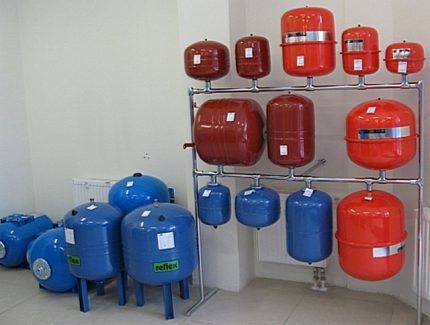
For residential premises, the following limit standards for the velocity of the coolant are recommended:
- with a conditional pipe passage of 10 mm - up to 1.5 m / s;
- with a conditional pipe passage of 15 mm - up to 1.2 m / s;
- with a conditional pipe passage of 20 mm or more - up to 1.0 m / s;
- for utility rooms of residential buildings - up to 1.5 m / s;
- for auxiliary buildings - up to 2.0 m / s.
In natural circulation systems expansion tank usually put on the pitch. But if the design will be supplemented by a circulation pump, it is usually recommended to move the drive to the return.
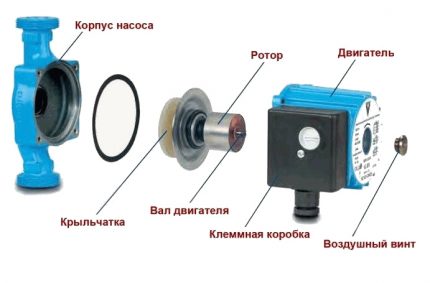
In addition, instead of an open tank, you should put a closed one. Only in a small apartment, where the heating system has a small length and a simple device, you can do without such a rearrangement and use the old expansion tank.
Calculations for forced heating systems
A properly organized system with forced circulation requires complex engineering calculations. But some formulas allow you to evaluate the state of the system and create a more accurate idea of the necessary alterations, especially when it comes to a small house or apartment. The power of the heating equipment is usually selected based on the size of the premises that are supposed to be heated.
Typically, manufacturers recommend: that the flow rate, taken in liters per minute, correspond to the number of kilowatts of boiler power. This means that for a 40 W boiler, a coolant flow rate of 40 l / min will be most suitable.
In the same way, the water consumption for a single room or group of rooms is calculated. In this case, they focus on the total power of the radiators installed on the site.
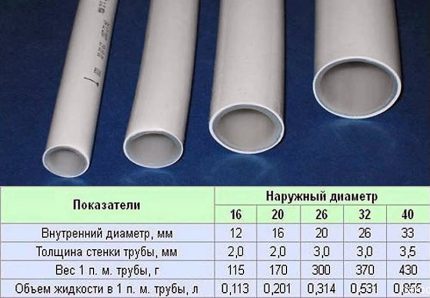
The diameter of the heating pipes is determined in accordance with the set flow rate of the coolant:
- at a flow rate of 5.7 l / min, half-inch pipes are needed;
- at a flow rate of 15 l / min, pipes are needed for three quarters of an inch;
- at a flow rate of 30 l / min inch pipes are required;
- at a flow rate of 53 l / min, pipes per inch and a quarter are needed;
- at a flow rate of 83 l / min, one and a half inch pipes are required;
- at a flow rate of 170 l / min, two-inch pipes are required;
- at a flow rate of 320 l / min, two and a half inch pipes, etc., are required.
To determine the parameters of a suitable circulation pump, it is necessary to measure the length of the entire heating circuit to which it will be connected. For ten meters of the system, a pump head of 0.6 m is needed. Using simple calculations, we get that for a system 60 meters long, a 3.6 m pump is needed.
However, these parameters are only valid for a system in which the diameter of the pipes is correctly selected, as indicated above. If too narrow communications are used, it will be necessary to take a more powerful pump in order to overcome the excess hydraulic pressure that arises in the system due to incorrect pipe selection.
Detailed recommendations for choosing a circulation pump we have given in this article.
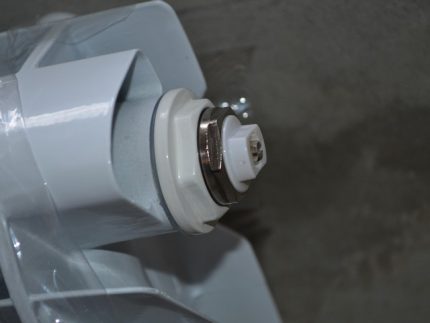
This rule also works in the opposite direction: if the pipes are wider than necessary by the standard, the rated capacity of the circulation pump should be reduced.
An important component of forced heating systems is the security group:
Experts recommend purchasing not one, but two such devices at once. One is the main one, and the second is in reserve. It can be installed on the bypass or stored in the pantry.
The circulation pump is usually resistant to breakdowns, but sensitive to the quality of the water in the heating circuit. To extend the operation of heating equipment, it makes sense to provide for filtering the coolant and timely measures for flushing system.
Circuit diagrams of pump circulation systems
Forced circulation heating systems are distinguished as follows:
- as one or two-pipe (option for connecting pipes to radiators);
- with vertical risers or horizontal highways;
- dead ends or with the passing movement of the heat carrier
- with top or bottom wiring.
Monotube systems are becoming less common, since their disadvantages far exceed the advantages. This is a very simple option, in which the radiators are connected in series. The coolant passes through each heater one by one, gradually cooling.
Obviously, with such a scheme, the first radiators will heat the room better than those located at the end of the system. It is necessary to install more radiators on the final section of the highway than at the beginning in order to smooth out the temperature difference.
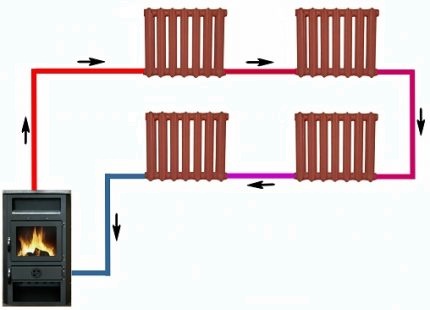
Such a device is extremely inconvenient, since it is impossible to turn off only one radiator in case of breakage, you will have to drain the coolant from the entire circuit. The two-pipe scheme involves connecting each radiator in parallel using two pipes to a common trunk.
Of course, for this you will have to use more materials, the total cost and time for installation will be higher than when using the single-tube version.
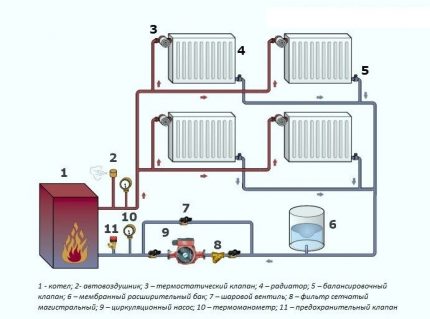
On each radiator with two-pipe connection, shut-off valves are installed.This makes it possible, if necessary, to remove or turn off only one radiator, while the remaining elements of the system continue to function in normal mode.
Warming up with such a scheme is carried out evenly, since the coolant enters each radiator in a separate line, and then returns to the boiler for heating, and does not move along the rest of the radiators.
Vertical risers are used in multi-storey buildings, it is convenient to connect radiators located on different floors to them. The vertical design contributes to the rapid removal of air entering the system, which significantly reduces the likelihood of air congestion.
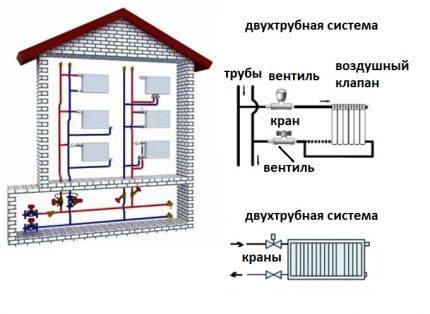
In horizontal schemes, the main highway, to which radiators are connected in parallel, is located, as the name implies, in a horizontal plane. This type of system is suitable for heating one-story buildings of a large area.
A relatively inexpensive option is not immune to the formation of air jams. To prevent problems of this kind, automatic air vents are used. The rules for removing the air plug from the heating system are detailed reviewed here.

Uneven heating is characteristic not only for single-pipe systems, but also for a dead-end version of heating, which is quite widespread.
In such a scheme, the flow of coolant is carried out in the direction opposite to the movement of the return. As a result, radiators appear in the system, which already receive a somewhat cooled coolant, which after them enters the return pipe.
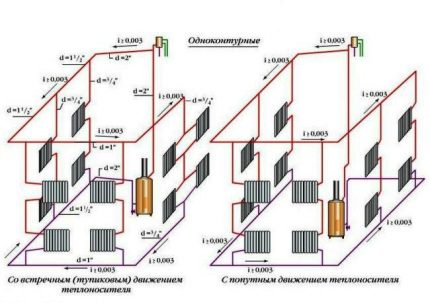
As a result, more heat comes to the first radiators from the riser, and less to the remote ones. In small areas, this moment may not be so noticeable, but in spacious houses it will be noticeable. In this situation, it is recommended to make several small lengths of pipelines than one long one, so that the entire coolant circulates along branches with approximately equal temperature.
A passing scheme is based on the same length of circulation rings throughout the house, which allows for extremely accurate uniformity of heating. But implementing this wiring option is not easy, since you will need to conduct a large number of pipes.
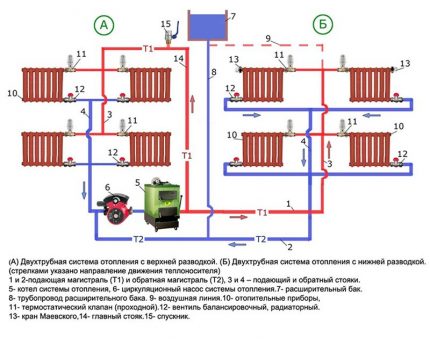
The upper and lower wiring were named at the location of the supply pipe. In the first case, the coolant enters the system from above, and in the second from below.
At the top wiring, the expansion tank is installed at the highest point of the system, the coolant is distributed through the system under the influence of gravitational forces. The return here will be below the radiators. To implement such a project in a private house, an attic is needed, on which a tank is installed.
If there are no conditions for the upper wiring, use the second option, when the coolant is supplied from below, and the return is installed above the radiators. The task of moving the coolant with a sufficiently high speed lies mainly with the circulation pump.
Such a scheme is mounted gradually, from the lower floor to the upper, while the supply line is made with a slight slope to prevent the occurrence of air jams.
To remove air jams, heating utilities are equipped with automatic air vents:
Where to put the circulation pump?
Most often, the circulation pump is installed on the return, and not on the supply. It is believed that there is a lower risk of rapid wear and damage to the device, since the coolant has already cooled. But for modern pumps, this is not necessary, since bearings with so-called water lubrication are installed there. They are already designed specifically for such operating conditions.
This means that it is possible to install a circulation pump at the feed, especially since here the hydrostatic pressure of the system is lower. The installation location of the device conditionally divides the system into two parts: the discharge area and the suction area. The pump installed on the supply, immediately after the expansion tank, it will pump water from the reservoir and pump into the system.

If the pump is installed on the return line in front of the expansion tank, it will pump water into the tank, pumping it out of the system. Understanding this point will help to take into account the features of hydraulic pressure at various points in the system. When the pump is running, the dynamic pressure in the system with an unchanged amount of coolant remains constant.
It is important not only to choose the best place for the installation of pumping equipment, but also to install it correctly. We recommend that you familiarize yourself with the nuances circulation pump installation.
The expansion tank creates the so-called static pressure. Relative to this indicator, an increased hydraulic pressure is created in the discharge area of the heating system, and a reduced hydraulic pressure is generated in the rarefaction region.
The vacuum can be so strong that it reaches atmospheric pressure or even lower, and this creates the conditions for air to enter the system from the surrounding space.
In the region of increasing pressure, air can, on the contrary, be pushed out of the system; sometimes, boiling of the coolant is observed. All this can lead to incorrect operation of heating equipment. To avoid such problems, overpressure in the suction area should be provided.
To do this, you can use one of the following solutions:
- raise the expansion tank to a height of at least 80 cm from the level of the heating pipes;
- place the drive at the highest point in the system;
- disconnect the drive pipe from the feed and transfer it to the return line after the pump;
- install the pump not on the return, but on the flow.
It is far from always possible to raise the expansion tank to a sufficient height. Usually they put it in the attic, if there is the necessary space. At the same time, it is important to adhere to the rules for mounting the drive in order to ensure its smooth operation.
Detailed recommendations on the installation and connection of the expansion tank, we have given in our other article.
If the attic is not heated, the drive will have to be insulated. It is quite difficult to rearrange the tank to the highest point in the forced circulation system if it was previously created as natural.
We will have to redo part of the pipeline so that the pipe slope is directed to the boiler. In natural systems, bias is usually made to the boiler.
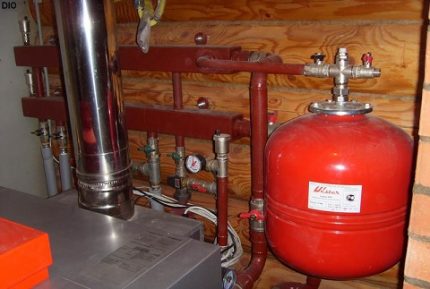
It is usually not difficult to change the position of the tank nozzle from the feed to the return. And it’s just as simple to implement the latter option: insert a circulation pump into the system on the supply line behind the expansion tank.
In such a situation, it is recommended to choose the most reliable pump model, which for a long time will be able to transfer contact with hot coolant.
Conclusions and useful video on the topic
You can find interesting information on forced heating systems in this video:
More detailed information on the calculations required when choosing a circulation pump is contained here:
In this video, the device and the installation procedure of the circulation pump are described in detail:
Forced heating systems are not as complex as they might seem at first glance. But in order to realize such a task, it is necessary to correctly perform the calculations and draw up a competent project. Under these conditions, you can provide your home with reliable and efficient heating.
Do you choose the optimal scheme for arranging a forced heating system in your home? Maybe you have questions that we did not consider in this article? Ask them to our expert in the comment block.
Or do you want to supplement the material with practical tips for installing pumping equipment? Write to us - your comments will help many newcomers.

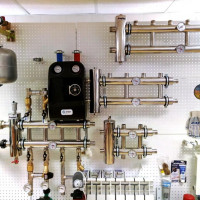 Natural circulation heating system: common water circuit designs
Natural circulation heating system: common water circuit designs 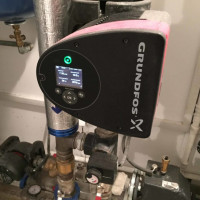 Compulsory circulation water heating system: schemes, implementation options, technical details
Compulsory circulation water heating system: schemes, implementation options, technical details 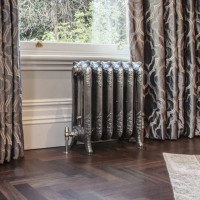 One-pipe heating system Leningradka: schemes and organization principle
One-pipe heating system Leningradka: schemes and organization principle 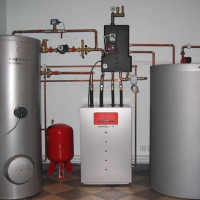 Closed heating system: schemes and installation features of a closed type system
Closed heating system: schemes and installation features of a closed type system  Schemes of a steam heating device + example of calculation of a steam system
Schemes of a steam heating device + example of calculation of a steam system 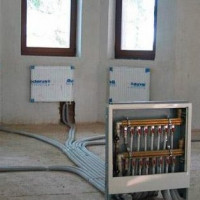 How the radial heating system works: schemes and wiring options
How the radial heating system works: schemes and wiring options  How much does it cost to connect gas to a private house: the price of organizing gas supply
How much does it cost to connect gas to a private house: the price of organizing gas supply  The best washing machines with dryer: model rating and customer tips
The best washing machines with dryer: model rating and customer tips  What is the color temperature of light and the nuances of choosing the temperature of the lamps to suit your needs
What is the color temperature of light and the nuances of choosing the temperature of the lamps to suit your needs  Replacement of a geyser in an apartment: replacement paperwork + basic norms and requirements
Replacement of a geyser in an apartment: replacement paperwork + basic norms and requirements
In the fall we bought a private house, solid, but, as it turned out, with problem heating.As I managed to understand, this is a two-pipe open system, water flows by gravity through the batteries. And in the last two rooms they are very cold. I increased the temperature on the boiler, drained the water, refilled it all the same.
Now I put the circulation pump, the radiators began to warm up much better. But ran into another problem when there is no light, again cold batteries. Well, at least the lights are rarely turned off.
Good afternoon. Your consultation is very necessary. We installed a solid fuel boiler, all according to the video. They took pipes 25, but alas, there was a problem - the circulation pump heats up very much, even when it drives cold water in the system. In this case, the boiler does not work, and the pump is fiery. What could be the problem?
We broke our heads - we checked it by pumping cold water from tank to tank, which stands on the street in the event of a water outage in the house, just as a reserve. In this case, the pump is cold. The expansion tank behind the stove in a makeshift box stands.
Hello. Since you checked the operation of the circulation pump by running water from another cold water tank, this eliminates several sources of problems.
Let's look at what could be the causes of overheating of the circulation pump:
1. The first reason is improper installation, which could lead to airing; the rotor axis could also shift;
2. Blockages in the heating system, which lead to an increase in the load on the equipment, and this in turn leads to overheating;
3. The insufficient pressure that occurs when the phase is incorrectly connected during three-phase connection to the heating circuit, which leads to a violation of the direction of movement of the blades and to overheating.
I think that a check on one of these points will allow you to detect and eliminate the cause of overheating.